Site pages
Current course
Participants
General
Module 1. Average and effective value of sinusoida...
Module 2. Independent and dependent sources, loop ...
Module 3. Node voltage and node equations (Nodal v...
Module 4. Network theorems Thevenin’ s, Norton’ s,...
Module 5. Reciprocity and Maximum power transfer
Module 6. Star- Delta conversion solution of DC ci...
Module 7. Sinusoidal steady state response of circ...
Module 8. Instantaneous and average power, power f...
Module 9. Concept and analysis of balanced polypha...
Module 10. Laplace transform method of finding ste...
Module 11. Series and parallel resonance
Module 12. Classification of filters
Module 13. Constant-k, m-derived, terminating half...
LESSON 28. Classification of filters
28.1. Classification of filters
Wave filters were first invented by G.ACampbell and O.I. Lobel of the Bell Telephone Laboratories. A filter is a reactive network that freely passes the desired bands of frequencies while almost totally suppressing all other bands. A filter is constructed from purely reactive elements, for otherwise the attenuation would never become zero in the pass band of the filter network. Filters differ from simple resonant circuits in providing a substantially constant transmission over the band which they accept; this band may lie between any limits depending on the design. Ideally, filters should produce no attenuation in the desired band, called the transmission band or pass band, an should provide total or infinite attenuation at all other frequencies, called attenuation band or stop band. The frequency which separates the transmission band and the attenuation band is defined as the cut-off frequency of the wave filters, and is designated by ƒc.
Filter networks are widely used in communication systems to separate various voice channels in carrier frequency telephone circuits. Filters also find applications in instrumentation, telemetering equipment, etc. where it is necessary to transmit or attenuate a limited range of frequencies.
A filter may, principle, have any number of pass bands separated by attenuation bands. However, they are classified into four common types, viz. low pass, high pass, band pass and band elimination.
Decibel and Neper
The attenuation of a wave filter can be expressed in decibels or nepers. Neper is defined as the natural logarithm of the ratio of input voltage (or current) to the output voltage (or current), provided that the network is properly terminated in its characteristic impedance Z0.
From Fig. 28.1 (a) the number of nepers, \[N={\log _e}\left[ {{{{V_1}} \over {{V_2}}}} \right]\,or\,\,{\log _e}\left[ {{{{I_1}} \over {{I_2}}}} \right]\]

Fig. 28.1 (a)
A neper can also be expressed in terms of input power, P1 and the output power P2 as N = ½ loge P1/P2.
A decibel is defined as en times the common logarithms of the ratio of the input power to the output power.
Decibel \[D=10\,{\log _{10}}{{{P_1}} \over {{P_2}}}\]
The decibel can be expressed in terms of the ratio of input voltage (or current) and the output voltage (or current).
\[D=10\,{\log _{10}}\left[ {{{{P_1}} \over {{P_2}}}} \right]\,\,=20\,\,{\log _{10}}\left[ {{{{I_1}} \over {{I_2}}}} \right]\]
One decibel is equal to 0.115 N.
Low Pass Filter
By definition, a low pass (LP) filter is one which passes without attenuation all frequencies up to the cut-off frequency fc, and attenuates all other frequencies greater than ƒc. The attenuation characteristic of an ideal LP filter is shown in Fig.28.1 (b). This transmits currents of all frequencies from zero up to the cut-off frequency. The band is called pass band or transmission band. Thus, the pass band for the LP filter is the frequency range 0 to ƒc. The frequency range over which transmission does not take place is called the stop band or attenuation band. The stop band for a LP filter is the frequency range above ƒc.
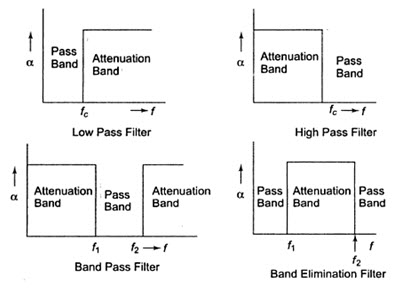
Fig.28.1 (b)
High Pass Filter
A high pass (HP) filter attenuates all frequencies below a designated cut-off frequency, ƒc, and passes all frequencies above ƒc. Thus the pass band of this filter is the frequency range above ƒc, and the stop band is the frequency range below ƒc. The attenuation characteristic of a HP filter is shown in Fig.28.1 (b).
Band Pass Filter
A band pass filter passes frequencies between two designated cut-of frequencies and attenuates all other frequencies. It is abbreviated as BP filter. As shown in Fig.28.1 (b), a BP filter has two cut-off frequencies and will have the pass band ƒ2 – ƒ1; ƒ1 is called the lower cut-off frequency, while ƒ2 is called the upper cut-off frequency.
Band Elimination Filter
A band elimination filter passes all frequencies lying outside a certain range, while it attenuates all frequencies between the two designated frequencies. It is also referred as band stop filter. The characteristic of an ideal band elimination filter is shown in fig.28.1 (b).
All frequencies between ƒ1 and ƒ2 will be attenuated while frequencies below ƒ1 and above ƒ2 will be passed.
28.2. Filter Networks
Ideally a filter should have zero attenuation in the pass band. This condition can only be satisfied if the elements of the filter are dissipation less, which cannot be realized in practice. Filters are designed with an assumption that the elements of the filters are purely reactive. Filters are made of symmetrical T, or p sections. T and p sections can be considered as combinations of unsymmetrical L sections as shown in Fig.28.2.

Fig.28.2
The ladder structure is one of the commonest forms of filter network. A cascade connection of several T and \[\pi\] sections constitutes a ladder network. A common form of the ladder network is shown in Fig.28.3.
Figure 28.3 (a) represents a T section ladder network, whereas Fig.28.3 (b) represents the \[\pi\] section ladder network. It can be observed that both networks are identical except at the ends.
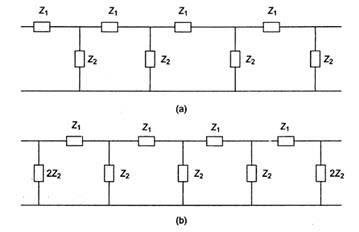
Fig. 28.3
28.3. Equations of Filter Networks
The study of the behavior of any filter requires the calculation of its propagation constant \[\gamma\] , attenuation \[\alpha\] , phase shift β and its characteristic impedance Z0.
T-Network
Consider a symmetrical T-network as shown in Fig.28.4
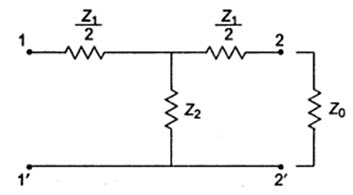
Fig.28.4
If the image impedances at port 1-1’ and port 2-2’ are equal to each other, the image impedance is then called the characteristic, or the iterative impedance, Z0. Thus, if the network in Fig.28.4 is terminated in Z0, its input impedance will also be Z0. The value of input impedance fro the T-network when it is terminated in Z0 is given by
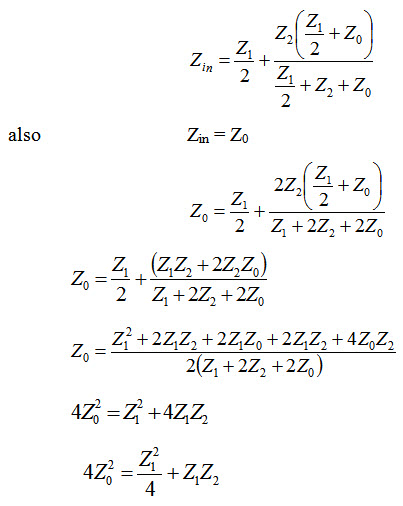
The characteristic impedance of a symmetrical T-section is
\[{Z_{0T}}=\sqrt {{{Z_1^2} \over 4} + Z_1^{}{Z_2}} ...................................................\left( {28.1} \right)\]
Z0T can also be expressed in terms of open circuit impedance ZOC and short circuit impedance ZSC of the T-netowrk. From Fig.17.4, the open circuit impedance \[Z_{OC}^{}={{{Z_1}} \over 2} + {Z_2}\,\,and\]

Propagation Constant of T-Network
By definition the propagation constant g of the network in Fig.28.5 is given by
\[\gamma\] = loge I1/I2
Writing the mesh equation for the 2nd mesh, we get
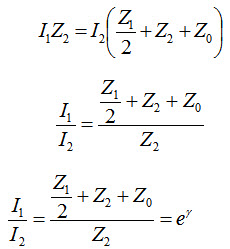
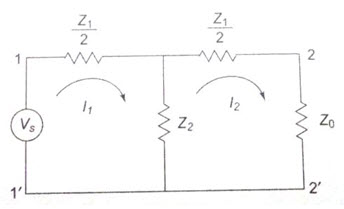
Fig.28.5
\[{{{Z_1}} \over 2} + {Z_2} + {Z_0}={Z_2}{e^\gamma }\]
\[{Z_0}={Z_2}\left( {{e^\gamma } - 1} \right) - {{{Z_1}} \over 2}...................................................\left( {28.3} \right)\]
The characteristic impedance of a T-network is given by
\[{Z_{OT}}=\sqrt {{{Z_1^2} \over 4} + {Z_1}{Z_2}} ...................................................\left( {28.4} \right)\]
Squaring Eqs. 28.3 and 28.4 and subtracting Eq.28.4 from Eq.28.3, we get
\[Z_2^2{\left( {{e^\gamma } - 1} \right)^2} + {{Z_1^2} \over 4} - {Z_1}{Z_2}\left( {{e^\gamma } - 1} \right) - {{Z_1^2} \over 4} - {Z_1}{Z_2}=0\]
\[Z_2^2{\left( {{e^\gamma } - 1} \right)^2} - {Z_1}{Z_2}\left( {1 + {e^\gamma } - 1} \right)=0\]
\[Z_2^2{\left( {{e^\gamma } - 1} \right)^2} - {Z_1}{Z_2}{e^\gamma }=0\]
\[{Z_2}{\left( {{e^\gamma } - 1} \right)^2} - {Z_1}{e^\gamma }=0\]
\[{\left( {{e^\gamma } - 1} \right)^2}={{{Z_1}{e^\gamma }} \over {{Z_2}}}\]
\[{e^\gamma } + 1 - 2{e^\gamma }={{{Z_1}} \over {{Z_2}{e^{ - \gamma }}}}\]
Rearranging the above equation, we have
\[{e^{ - \gamma }}\left( {{e^{2\gamma }} + 1 - 2{e^\gamma }} \right) = {{{Z_1}} \over {{Z_2}}}\]
\[\left( {{e^\gamma } + {e^{ - \gamma }} - 2} \right)={{{Z_1}} \over {{Z_2}}}\]
Dividing both sides by 2, we have
\[{{{e^\gamma } + {e^{ - \gamma }}} \over 2}=1 + {{{Z_1}} \over {2{Z_2}}}\]
Cosh \[\gamma =1 + {{{Z_1}} \over {2{Z_2}}}...................................................\left( {28.5} \right)\]
Still another expression may be obtained for the complex propagation constant in terms of the hyperbolic tangent rather than hyperbolic cosine.
\[\sinh \,\gamma=\sqrt {\cos \,{h^2}\gamma-1}\]
\[=\sqrt {{{\left( {1 + {{{Z_1}} \over {2{Z_2}}}} \right)}^2}}-1=\sqrt {{{{Z_1}} \over {{Z_2}}} + {{\left( {{{{Z_1}} \over {2{Z_2}}}} \right)}^2}} \]
\[Sinh\,\,\gamma=\,{1 \over {{Z_2}}}\sqrt {{Z_1}{Z_2} + {{Z_1^2} \over 4}}={{{Z_{0T}}} \over {{Z_2}}}...................................................\left( {28.6} \right)\]
Dividing by Eq.28.6 by Eq.28.5, we get

But \[{Z_2} + {{{Z_1}} \over {{Z_2}}}={Z_{0C}}\]
Also from Eq. 28.2, \[\tanh \,\,\gamma=\sqrt {{{{Z_{sc}}} \over {{Z_{0c}}}}}\]
\[\tanh \,\,\gamma=\sqrt {{{{Z_{sc}}} \over {{Z_{oc}}}}}\]
Also \[\sinh \,{\gamma\over 2}=\sqrt {{1 \over 2}\left( {\cosh \,\,\gamma-1} \right)}\]
Where \[\cosh \,\,\gamma=1 + \left( {{Z_1}/2{Z_2}} \right)\]
\[=\sqrt {{{{Z_1}} \over {4{Z_2}}}} ...................................................\left( {28.7} \right)\]
\[\pi\] -Network
Consider asymmetrical p-section shown in Fig.28.6. When the network is terminated in Z0 at port 2-2’, it input impedance is given by

By definition of characteristic impedance, Zin = Z0
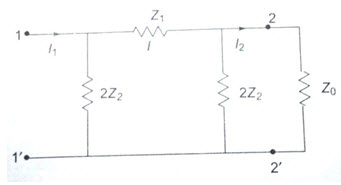
Fig.28.6
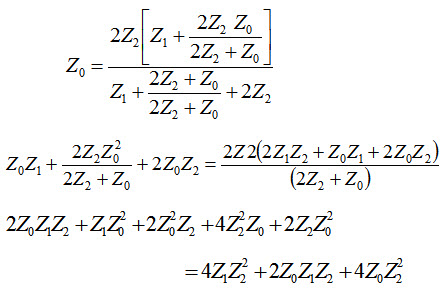
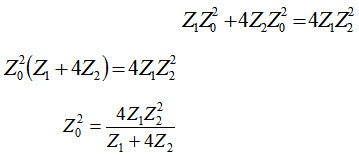
Rearranging the above equation leads to
\[{Z_0}=\sqrt {{{{Z_1}{Z_2}} \over {1 + {Z_1}/4{Z_2}}}} ...................................................\left( {28.8} \right)\]
which is the characteristic impedance of a symmetrical pnetwork,
\[{Z_{0\pi }}=\sqrt {{{{Z_1}{Z_2}} \over {{Z_1}{Z_2} + Z_1^2/4}}\]
From Eq. 28.1 \[{Z_{OT}}=\sqrt {{{Z_1^2} \over 4} + {Z_1}{Z_2}}\]
\[{Z_{0\pi }}={{{Z_1}{Z_2}} \over {{Z_{OT}}}}...................................................\left( {28.9} \right)\]
Z0p can be expressed in terms of the open circuit impedance Z0c and short circuit impedance ZSC of the p network shown in Fig.28.6 exclusive of the lead Z0.
\[by\,\,\,\,{Z_{0C}}={{2{Z_2}\left( {{Z_1} + 2{Z_2}} \right)} \over {{Z_1} + 4{Z_2}}}\]
Similarly, the input impedance at port 1-1’ when port 2-2’ is short circuited is given by
\[{Z_{sc}}={{2{Z_1}{Z_2}} \over {2{Z_2} + {Z_1}}}\]
Hence \[{Z_{oc}} \times {Z_{sc}}={{4{Z_1}Z_2^2} \over {{Z_1} + 4{Z_2}}} = {{{Z_1}{Z_2}} \over {1 + {Z_1}/4{Z_2}}}\]
Thus from Eq. 28.8
\[{Z_{0\pi }}=\sqrt {{Z_{oc}}{Z_{sc}}} ...................................................\left( {28.10} \right)\]
Propagation Constant of p-Network
The propagation constant of a symmetrical p-section is the same as that for a symmetrical T-section.
i.e. \[\cosh \,\,\gamma=1 + {{{Z_1}} \over {2{Z_2}}}\]